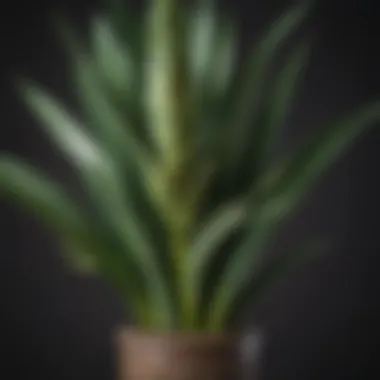Indoor Plants for Good Energy: Enhance Your Vitality


Intro
Indoor plants are more than just decorative elements in our homes and offices; they are vital contributors to our overall energy and vitality. Research has shown that plants can influence both psychological and physiological well-being. In this article, we will explore the intimate relationship between indoor plants and the energy they can generate in various spaces.
As we delve into specific plant species known for their energetic properties, we will also examine how selecting and caring for these plants can create a harmonious environment. This exploration will cater especially to those interested in astrology, as we'll connect the dots between specific plants and their alignment with zodiac characteristics.
Understanding the Zodiac
Astrology has long been a tool for self-discovery and understanding the world around us. By examining zodiac signs and their unique traits, we can subtly align our living spaces with our personal energies. In doing so, we create an atmosphere that enhances vitality and well-being.
Overview of Zodiac Signs
Zodiac signs are based on twelve astrological divisions, each associated with specific personality traits and energies. These signs range from Aries to Pisces, with each sign embodying distinct characteristics. When considering indoor plants, it may be beneficial to select species that resonate with your zodiac sign to enhance personal energy.
Sign Traits and Characteristics
Each zodiac sign has a range of traits such as passion, creativity, and intuition. For example:
- Aries: Energetic and adventurous
- Taurus: Grounded and nurturing
- Gemini: Adaptable and communicative
By understanding these traits, individuals can choose plants that complement their personalities, potentially boosting their energy accordingly.
Elemental Qualities
Zodiac signs are also grouped by elements: Fire, Earth, Air, and Water. Each element influences the overall energy that the sign embodies. For instance:
- Fire Signs (Aries, Leo, Sagittarius): Thrive with vibrant, dynamic plants like the Rubber Plant or Cactus.
- Earth Signs (Taurus, Virgo, Capricorn): Benefit from nurturing plants such as Snake Plant and Pothos.
- Air Signs (Gemini, Libra, Aquarius): Suit airy, flowing plants like Spider Plant or Peace Lily.
- Water Signs (Cancer, Scorpio, Pisces): Flourish with calming plants such as Boston Fern and Orchid.
Choosing plants based on elemental qualities can amplify energy and enhance the balance in personal spaces, leading to improved focus and vitality.
“Selecting indoor plants that resonate with zodiac energies can transform your living environment into a sanctuary of positive energy.”
In summary, understanding the zodiac signs and their traits helps in identifying the perfect indoor plants for enhancing energy. Next, we will explore how astrological insights can further guide the selection and care of these essential green companions.
Understanding the Concept of Energy in Indoor Spaces
The significance of energy in indoor spaces is a central theme in this article. Understanding this concept applies not only to the physical ambience but also to the overall well-being of individuals residing or working in these environments. The energy present in a space can directly influence mood, productivity, and health. By acknowledging the role of energy, one can better appreciate how indoor plants contribute to creating a positive atmosphere.
Defining Energy in Relation to Environment
Energy, in relation to environment, refers to the vibrational frequencies and life force present in a given space. This energy can be positive, negative, or neutral, influencing the experiences of the occupants. Positive energy tends to uplift, inspire, and promote harmony, while negative energy may generate unease or lethargy.
One important aspect is how physical elements interact with the energy of a space. Natural elements, such as light, air, and flora, possess intrinsic energy that enhances vitality. Incorporating indoor plants allows for a moderation of this energy, as greenery helps to purify air and create a more serene atmosphere. Thus, by integrating plants within home or office, it becomes easier to foster good energy and enhance the overall experience in those environments.
How Indoor Spaces Affect Well-being
Indoor spaces significantly influence individuals' well-being in various ways. Poorly designed environments might induce stress, fatigue, or even sadness. Observable factors such as clutter, darkness, and lack of nature impact mental state. Conversely, thoughtfully curated spaces can enhance clarity, focus, and tranquility.
Surroundings rich in natural elements can lead to improved mood and reduced anxiety. Research indicates that exposure to indoor plants can help lower feelings of discomfort and promote positivity. Additionally, green spaces have been linked to increased creativity and cognitive functions. This is particularly valuable for professionals and artists seeking innovative solutions.
Implementing indoor plants fosters not just visual beauty, but also engages the senses, providing an organic touch to sterile environments. Here are some benefits of plants on well-being:
- Aesthetic appeal: Visually pleasing, creating a more inviting atmosphere.
- Air purification: Plants filter toxins and improve air quality.
- Stress relief: Greenery can reduce stress levels and enhance relaxation.
- Increased productivity: Environments with plants can lead to higher levels of focus and functionality.
- Connection to nature: Boosts mental health via enhanced sensory stimulation and emotional balance.


The Role of Indoor Plants in Energy Optimization
Indoor plants serve as more than just decor. Their presence in a space can significantly influence energy levels and the overall ambiance. Understanding their role in energy optimization is crucial for anyone looking to enhance vitality within their environment. The integration of plants into indoor spaces provides a pathway to not only improve aesthetics but also to foster a more vibrant and balanced atmosphere. Specific elements such as air purification, stress reduction, and a sense of connection to nature are some of the benefits to be considered.
Physiological Benefits of Indoor Plants
Research suggests that indoor plants offer notable physiological benefits. These benefits arise from their ability to improve air quality and create a more conducive environment for well-being. Plants like the Snake Plant and Peace Lily improve indoor air quality by filtering out harmful toxins.
Air Quality and Health
Better air quality leads to various health improvements. For instance:
- Reduced respiratory issues and allergies.
- Improved concentration and productivity.
- Enhanced mood and energy levels.
Scientific studies have shown that being around plants can increase the levels of oxygen and reduce carbon dioxide in the space. This boosts overall vitality. Moreover, a greener environment can lower blood pressure and enhance recovery in hospital settings.
Psychological Impacts of Natural Elements
The psychological impacts of having indoor plants extend beyond mere aesthetics. Exposure to natural elements, such as plants, has a profound effect on our mental well-being. For those interested in astrology, this connection can be particularly relevant, as certain plants can harmonize with an individual's character and mood.
Emotional Well-being
Having indoor plants can:
- Decrease stress and anxiety levels.
- Enhance feelings of calmness and contentment.
- Foster a greater connection to nature, even within urban settings.
Studies indicate that interacting with plants can evoke positive emotions. Incorporating plants into a living or working space can help people feel more focused and balanced. Through their visual and physical presence, plants ground our emotions, making us feel more connected to our surroundings.
“The presence of plants is linked to enhanced well-being and reduced mental fatigue.”
In summary, understanding the role of indoor plants in energy optimization goes beyond awareness of how they affect the physical space. Their physiological benefits, coupled with their psychological impacts, create a holistic approach to enhancing vitality. Thus, integrating indoor plants into spaces not only beautifies them but also facilitates a more vibrant existence.
Selecting the Right Indoor Plants for Energy
Choosing the right indoor plants is essential for enhancing energy within living and working spaces. Different plants possess unique properties that can influence not only the appearance of a space but also the mood and vitality of its occupants. Selecting plants that resonate with personal energy and environment improves overall well-being, creating a harmonious atmosphere conducive to productivity and relaxation. Furthermore, understanding these plants' characteristics helps in making informed choices that benefit personal and environmental health.
Plants Known for Energy Enhancement
Snake Plant
The Snake Plant, also known as Sansevieria, is celebrated for its air-purifying qualities. This plant is particularly beneficial for indoor environments because it converts carbon dioxide into oxygen during the night. Its tall, upright leaves provide a sense of strength and resilience, making it a popular choice for spaces that require a boost in energy levels. The low maintenance nature of the Snake Plant adds to its appeal, as it can thrive in a variety of lighting conditions.
However, Snake Plants can be slightly toxic if ingested, which is a consideration for households with pets or small children. Despite this drawback, the plant serves as an effective energy enhancer due to its robust presence and oxygen-producing abilities.
Peace Lily
The Peace Lily, known scientifically as Spathiphyllum, is another excellent choice for indoor energy enhancement. This plant is renowned for its delicate white flowers and lush green foliage. An important aspect of the Peace Lily is its ability to remove harmful toxins from the air, such as formaldehyde and benzene. This purification contributes to a cleaner atmosphere, promoting a sense of well-being among its surroundings.
The Peace Lily requires minimal care and can adapt to low light conditions, making it a practical option for many indoor spaces. Its unique ability to thrive in less-than-ideal environments underscores its importance in creating a positive energy flow.
Spider Plant
The Spider Plant, or Chlorophytum comosum, is a popular choice for both novice and experienced plant owners. Its distinctive arching leaves and the production of offshoots, or


Caring for Indoor Plants to Maintain Positive Energy
Caring for indoor plants is not merely an act of maintenance; it is an integral part of cultivating a positive energy flow in your space. The vitality of these plants directly influences the atmosphere, contributing to your overall well-being. A well-cared-for plant can enhance your environment, promoting calmness and clarity. Conversely, neglected plants may create an energy drain, impacting the quality of your living or working space.
Optimal Light Conditions for Growth
Light is one of the most crucial factors for the health of indoor plants. Each plant species has specific light requirements, which are foundational for their growth. Understanding these light conditions can vastly improve a plant's energy contribution to your space.
Some plants thrive in bright, direct sunlight, while others prefer indirect light. Assess the lighting in your environment and select plants that align with these conditions. For example, the Snake Plant tends to do well in low light, making it suitable for darker corners, while a Peace Lily flourishes in brighter spaces.
Consider rotating your plants occasionally to ensure even light exposure. This simple practice can significantly enhance their health and, consequently, the energy they provide.
Watering Techniques to Ensure Health
Watering is another vital aspect of plant care. It requires a balance; over-watering can lead to root rot, while under-watering can cause wilting. Understanding the specific needs of your indoor plants is essential to keeping them healthy.
Most indoor plants prefer their soil to dry out slightly between watering. Make a habit of checking the soil moisture before watering. A simple finger test can suffice—stick your finger an inch into the soil. If it feels dry, it's time to water.
In general, watering in the morning can be beneficial as it reduces evaporation and allows plants to absorb moisture throughout the day. When you water, ensure it reaches the roots by allowing it to drain completely, promoting nutrient uptake and vibrant growth.
Nutrient Requirements and Fertilization
Indoor plants, like all living organisms, require nutrients to thrive. Providing the right level of fertilization ensures that plants have the energy they need to grow and flourish effectively.
Different plants require different types of fertilizer. For example, a balanced liquid fertilizer can be suitable for general-purpose plants, while specific blends might be necessary for succulents or flowering plants. Always opt for products that are organic whenever possible, as they are better for indoor air quality and the environment.
Frequency of fertilization is also important. A general rule is to fertilize during the growing season, which is typically spring and summer. However, during the fall and winter, many plants enter dormancy and require less attention.
It's beneficial to read closely the instructions on the fertilizer label. Proper application can mean the difference between a healthy plant and a struggling one.
By focusing on these specific areas—light, water, and nutrients—you can create an environment that promotes positive energy through the vitality of your indoor plants. Taking the time to care for your plants will not only enhance their health but also the energy they contribute to your atmosphere.
Creating an Energy-Conducive Environment
Creating an energy-conducive environment is essential for enhancing vitality in indoor spaces. The way we design and arrange our living areas can significantly impact our mood, productivity, and overall well-being. Integrating indoor plants into these spaces can amplify positive energy, promoting a harmonious atmosphere that resonates with both the physical and metaphysical aspects of our lives.
Designing Spaces with Plants in Mind
When designing spaces with plants, it is crucial to consider both the aesthetic and energetic aspects. The placement of each plant can influence energy flow, creating an uplifting ambiance. Here are some key considerations:
- Light Conditions: Different plants require different lighting. Ensure that each plant is placed in a location where it gets adequate sunlight for photosynthesis while avoiding direct, harsh light if it’s detrimental to their health.
- Spatial Arrangement: Group plants together in clusters. This not only creates a visually appealing look but may also enhance energy circulation. Consider the height and leaf shape of plants to achieve a balanced visual effect.
- Functional Spaces: Acknowledge the function of each space before selection. For example, in a workspace, using invigorating plants like the Snake Plant can help maintain focus. In relaxation areas, Peace Lilies, known for their calming properties, are advisable.
By thoughtfully designing spaces with plants, one can cultivate an environment that nurtures both physical and spiritual well-being.
Combining Plants with écor for Energy Flow
Integrating plants with décor is another vital aspect. It can create an energetic flow that enhances the overall feel of the environment. Several elements should be taken into account:
- Color Coordination: Choose planters that complement your interior design, aligning with the color patterns of a room. Earth tones are often grounding, while brighter hues can lift energy levels.
- Natural Materials: Using materials like ceramic, metal, or wood for pots gives a tactile element that echoes the natural world. This creates a smoother transition between flora and the indoor setting.
- Symbolism and Intention: Many plants carry meanings and symbolism, especially within astrological contexts. Rosemary might be used for remembrance, while lavender for relaxation. Placing them thoughtfully can align with personal intentions, enhancing both beauty and energy.
The synergy between plants and décor is profound. It not only contributes to improved aesthetics but also creates a sense of tranquility and balance.
By combining plants with decor, one creates an energy flow that enriches the living experience. This strategic approach fosters a space that embodies vitality and coherence, integral for those seeking both aesthetic pleasure and energetic harmony.


Personal Experiences and Case Studies
Understanding the significance of personal experiences and well-documented case studies in the context of indoor plants and their impact on energy is crucial. These narratives provide real-world insights into the practical applications of integrating plants within living and working spaces. They can reveal how various species can enhance vitality, improve mental clarity, and create an atmosphere that feels more balanced and harmonious.
Personal stories can often resonate more profoundly than academic research. They offer relatable examples of how individuals have navigated the challenges of maintaining plants, how they observed shifts in their surroundings, and the subsequent effects on their mood and productivity. Case studies also create a bridge between theoretical concepts and lived experiences, making them more accessible to readers, especially those interested in astrology and holistic living.
This section aims to showcase the tangible benefits indoor plants can bring, illustrating the overarching theme of energy enhancement through various real-life and scientifically validated examples.
Real-life Testimonials
Many individuals have shared compelling accounts of their journeys with indoor plants and how these green companions have affected their daily lives. For example, one user, who struggled with anxiety in her small apartment, found solace in incorporating several Snake Plants. She noted that the presence of these plants not only improved the air quality but provided a sense of calmness that helped her manage her stress. This supports the idea that certain plants hold specific energetic properties beneficial for emotional well-being.
Another testimonial comes from an office worker who introduced Peace Lilies to her workspace. She observed that her focus improved and her fatigue decreased significantly. This experience aligns with findings that suggest greenery in workplaces can boost creativity and reduce stress, fostering a more energizing environment.
These stories exemplify how indoor plants can transcend mere aesthetics, contributing to mental and emotional well-being.
Scientific Studies on Plants and Energy
Numerous scientific studies substantiate the claims regarding the benefits of indoor plants. Research consistently indicates that plants contribute positively to our health and well-being. A notable study published in the Journal of Environmental Psychology found that individuals working in spaces adorned with greenery reported higher levels of satisfaction, creativity, and overall productivity compared to those in plant-free environments.
Another significant piece of research focused on the relationship between plants and air quality. According to the NASA Clean Air Study, specific indoor plants like Rubber Plants and Spider Plants can effectively purify air by removing toxins. Clean air directly correlates with energy levels, mood stabilization, and improved cognitive function.
Research by the University of Queensland indicates that people perceive indoor plants as enhancing their physical environment, thus feeling happier and healthier.
The scientific evidence underscores the importance of incorporating plants into our indoor spaces, aligning perfectly with the article’s theme of enhanced vitality. By pairing personal experiences with empirical data, readers, especially those attuned to esoteric practices, can appreciate how plants serve as an essential tool in promoting good energy.
Challenges and Solutions in Maintaining Indoor Plants
Maintaining indoor plants can be a rewarding yet challenging endeavor. Understanding these challenges is critical for anyone seeking to create a positive energy environment. Knowledge of common plant issues allows owners to overcome them effectively, ensuring that their green companions thrive. The process of caring for indoor plants involves awareness of their specific requirements, whether in light, water, or nutrients. By recognizing these aspects, one can enhance not only the vitality of the plants but also the energy of the space they inhabit.
Common Issues Faced by Plant Owners
Indoor plants, though beneficial, do come with their own set of challenges. Some of the most frequent issues that plant owners encounter include:
- Poor Light Conditions: Many plants fail to thrive due to insufficient or excessive light. Each species has its specific needs, and finding the balance is crucial.
- Overwatering or Underwatering: This is one of the leading causes of plant stress. Each plant requires a distinct watering schedule, impacted by factors like humidity and temperature.
- Nutrient Deficiency: A lack of essential nutrients can stunt growth and lead to diseases. Recognizing signs of deficiency, such as yellowing leaves, is important for timely intervention.
- Pest Infestation: Indoor plants may attract pests like aphids or spider mites, which can harm them. Early detection is key to preventing extensive damage.
- Temperature Fluctuations: Sudden changes in temperature can stress the plants. Ideal temperatures should be maintained to keep the plants healthy.
Tips for Overcoming Plant Care Challenges
To successfully manage indoor plants, it is important to employ effective strategies in order to overcome common issues. Here are some practical tips:
- Research Plant Requirements: Before purchasing any plant, research its specific light, watering, and nutrient needs. This knowledge can prevent many issues before they arise.
- Monitor Watering Practices: Establish a schedule that accounts for light and humidity conditions. Consider using moisture meters to assist with proper watering intervals.
- Fertilize Wisely: Use appropriate fertilizers to nourish plants. Follow instructions carefully to avoid over-fertilization, which can be detrimental.
- Regular Inspection: Check plants regularly for signs of pests or disease. Early identification simplifies remedying such issues, reducing stress on the plant.
- Maintain Steady Temperatures: Ensure that indoor plants are kept in stable environments, away from heaters or air conditioning units, as these can lead to rapid temperature shifts.
By addressing challenges skillfully, plant owners can create environments that foster vitality and balance, resonating well with both their own needs and the plants’.
Finale
Reflecting on the Importance of Indoor Plants
The significance of indoor plants extends beyond mere aesthetics; it touches on fundamental aspects of well-being and vitality. Plants have been shown to improve air quality, which can lead to better health outcomes. They can elevate one's mood and reduce stress, providing a serene counterbalance to chaotic environments. Importantly, these plants serve as conduits of energy, fostering an environment that vibrantly resonates with its inhabitants. This resonance often aligns with the principles of feng shui or other energetic practices, where the placement of green life sources can harmonize the flow of energy in a room.
Another consideration is the psychological benefit derived from interacting with nature. Studies support the idea that individuals who incorporate plants into their living spaces report higher levels of productivity and lowered anxiety levels. The recommended species outlined earlier do not only provide physiological benefits but also function as vital emotional anchors. Thus, choosing the right indoor plants can be an intentional act towards cultivating a positive atmosphere, reinforcing the need for mindful selection.
Encouragement to Explore Personal Connections
As you delve into the world of indoor plants, consider your personal relationship with them. Each plant type offers unique energies and attributes. From the resilient Snake Plant to the elegant Peace Lily, each species can resonate differently based on personal preferences or even astrological affiliations. This layer adds depth to the interaction with your indoor plants, transforming them from mere decor into dynamic partners in your living space.
Reflect on what specific emotional or energetic needs you may have. Are you seeking tranquility? Or perhaps creative stimulation? These queries can guide plant selections. Additionally, maintaining these plants can forge further bonds; caring for them becomes a ritual that enhances personal space and well-being.
In encouraging exploration, I invite you to also share your experiences with like-minded individuals. Social media platforms like Reddit or groups on Facebook allow for the exchange of ideas, tips, and experiences that nurture a community passionate about integrating plants into their lives. It is through these connections that the journey into nurturing indoor plants becomes not just a practice, but a personal exploration of energetics and well-being.







